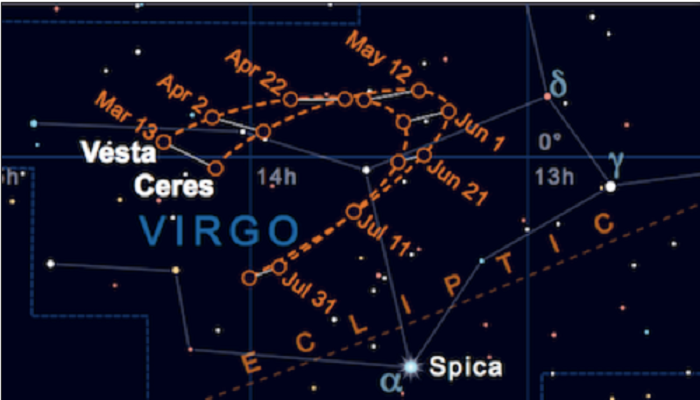.
It's not just the red planet Mars which is wowing astronomers this month. The dwarf planet Ceres and the brightest minor planet (4) Vesta lie a mere two degrees apart, just 15 degrees (a fist held at arm's length from knuckle-to-knuckle spans 10 degrees) northeast of Mars (to the upper left from the Northern Hemisphere) among the stars of Virgo.
.

Both asteroids are at their best this month, coming to opposition (opposite the Sun in the sky) within days of each other, Vesta first on 13 April, followed by Ceres on 15 April. Vesta is the third biggest asteroid behind Ceres and (2) Pallas, with a diameter of 525 km (326 miles). Vesta contains more mass than Pallas though and it's easily the brightest of all the asteroids; it can get as bright as magnitude +5.1 but this month it peaks at a still very respectable +5.8, in theory rendering it visible to the naked eye at the darkest of sites in the best conditions.
It is worth having a go at trying to image it as it will be around 0.7 arcseconds in apparent diameter; ace astrophotographer Damian Peach has succeeded in recording a disc. Visual observers can see it easily in binoculars and its nightly retrograde motion against the background stars can be sketched or imaged easily enough. Its precise position on opposition night is RA 13h 52m 02.4s, Dec +02° 08' 33".
Ceres is the largest object in the Asteroid Belt by far with a diameter of 950 km (590 miles) and accounting for a third of the mass of the belt. It can be as bright as +6.7 but this month it shines at best at magnitude +6.9. Ceres comes to opposition at a distance from the Earth of 1.644 AU (Astronomical Unit; the Earth-Sun distance), or 245.9 million km (152.8 million miles), some 61 million kilometres further away than Vesta, which accounts for it being nearly two magnitudes fainter. Ceres is slightly bigger in apparent diameter at 0.85 arcseconds and is an easy binocular object. Its precise position at opposition is RA 13h 57m 44.9s, Dec +02° 54' 11".
The two remain in tandem in Virgo, four to six degrees northwest of zeta Virginis (magnitude +3.4) through into the summer. From the UK, the pair culminate in April due south around 1:30am BST some 40 degrees above the southern horizon. They can be observed above 20 degrees altitude from about 9:30pm until about 5am, when morning twilight and low altitude starts becoming a problem.
The pair continue to creep ever-closer as the weeks pass, with Vesta reaching its second stationary point on 1 June, followed swiftly by Ceres on 7 June. Their direct, easterly motion through Virgo brings them to a very close conjunction on 5 July, when they will be a mere 10 arcminutes apart, the closest that anyone will ever have observed them before. By this time the pair will be 1.5 degrees south of zeta, Vesta shining at magnitude +6.2 and Ceres +7.4, but still a fine sight in binoculars and telescopes around 11pm as darkness falls.
Quelle: AN

